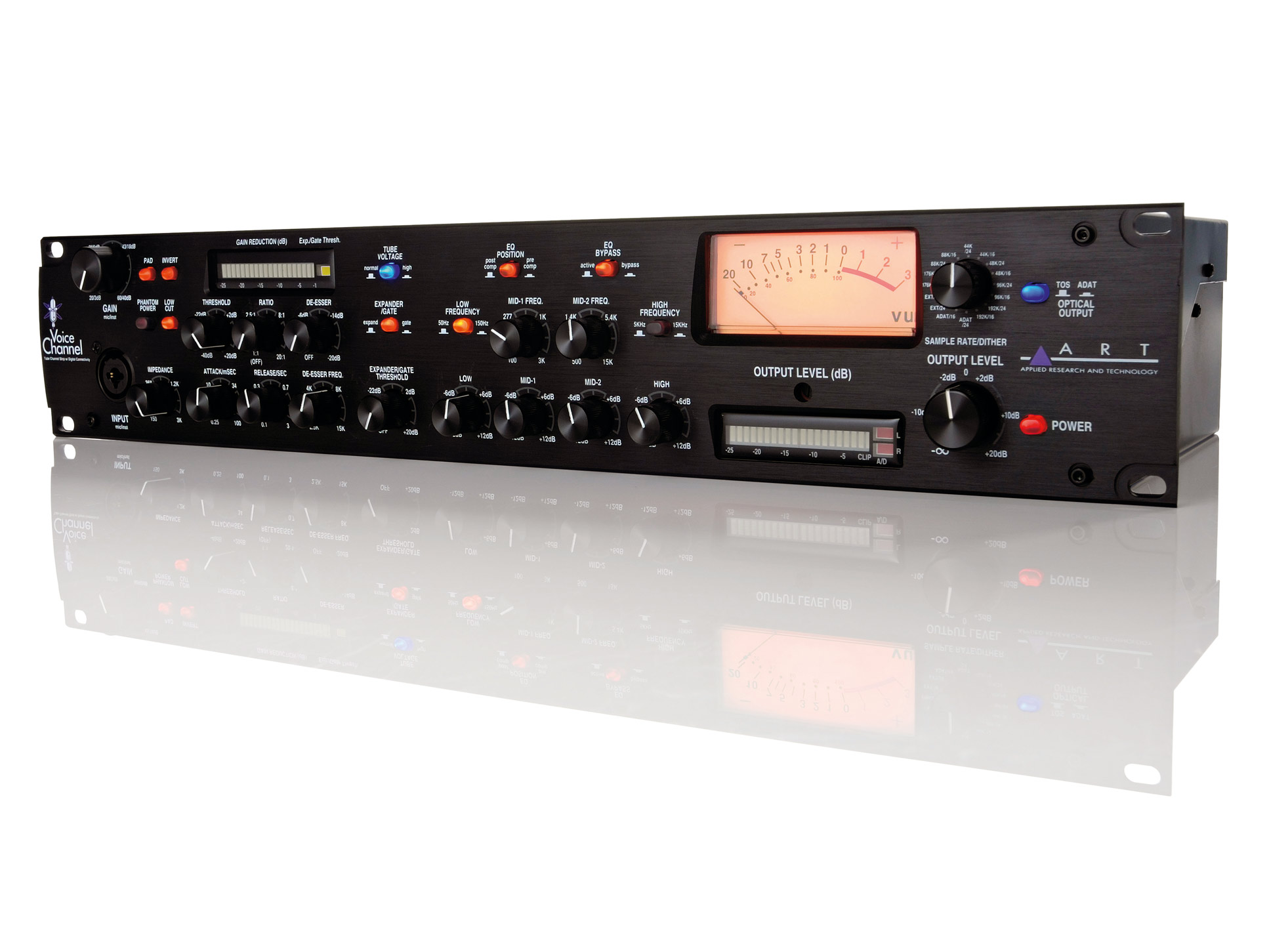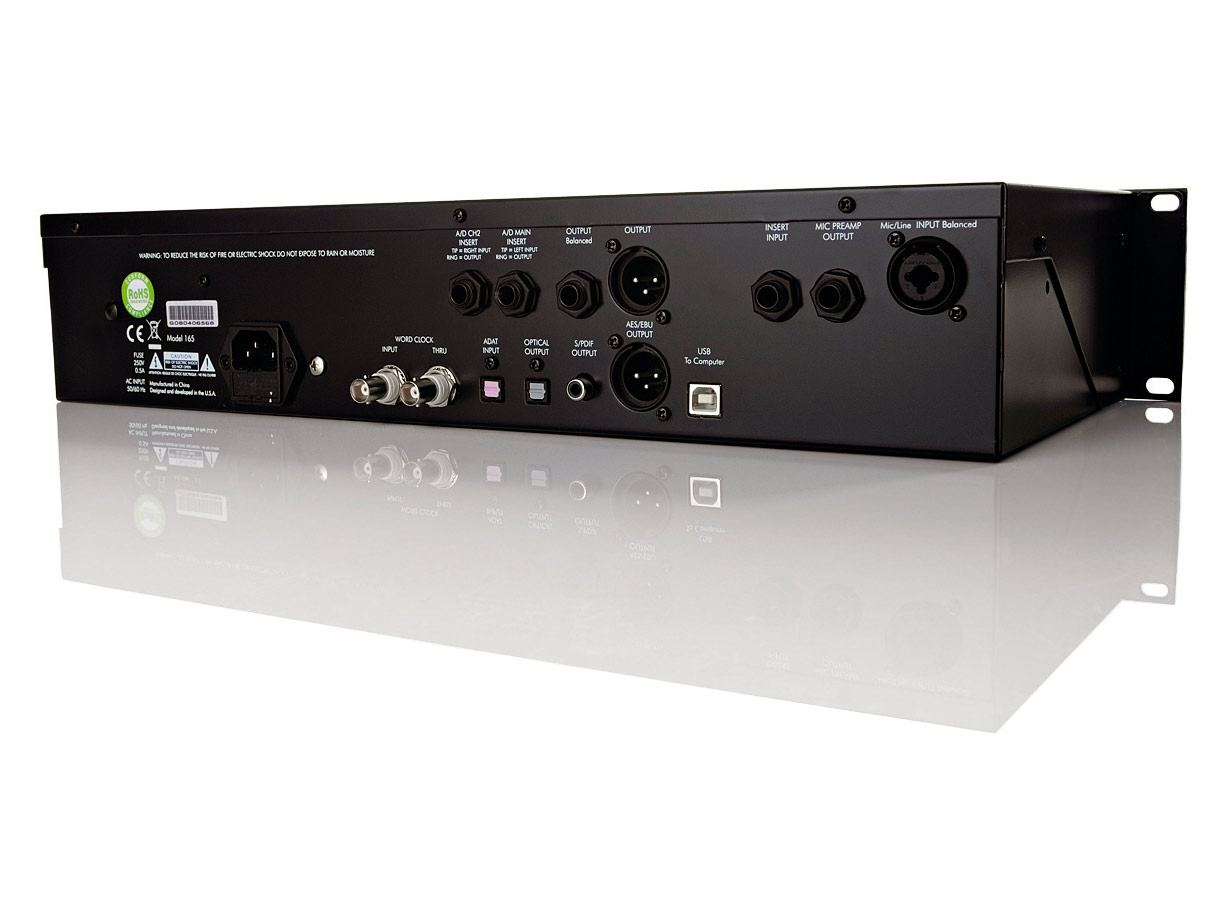MusicRadar Verdict
A good quality sound in a well-built, finger-friendly box with impressive routing and digital connections.
Pros
- +
Switchable valve supply voltage. Quality preamp. Excellent external routing and digital connections.
Cons
- -
De-esser is a little ineffective. EQ may not be to your preference.
MusicRadar's got your back

ART Voice Channel

ART Voice Channel
Ever since someone ripped out a mixing desk channel and put it in a rack box, manufacturers have been lining up to offer their take on the audio jack-of-all-trades that is the channel strip. The Voice Channel as ART's all-in-one-box recording solution.
Overview
The preamp section comprises mic, line and instrument inputs via front- and rear-mounted combo XLR/ jack sockets. After the usual pad, low-cut, phase invert and +48v buttons there's a mic impedance knob to allow for the use of low-impedance ribbon mics as well as frequency response tailoring for most other mics.
Next in line is the dynamics section with threshold, ratio, attack and release controls for the compressor. There's no on/off button but the 1:1 ratio is labelled 'off' as it has no dynamic effect, which saves on front panel space but makes A/B checking less instant.
The Voice Channel features a de-esser, but instead of making this a separate section it has been added into the compressor (with threshold and frequency controls) and allows for more compression at the selected frequency.
The final part of the dynamics section is the expander/gate (a button above switches modes) and this features a single threshold control. A light next to the gain reduction LEDs indicates when the expander/gate is working its magic.
Above the expander controls, stranded all on its own, is the tube voltage button that switches the valve supply voltage between 'normal' and 'high'. The lower voltage allows the valve to distort at a lower gain level and thus impart more of a 'valve sound', while the high voltage increases headroom and bandwidth.
The EQ section comprises a high- and low-shelf with two switchable frequencies: 50Hz/150Hz and 5kHz/15kHz respectively. Between these are two fixed Q-mid band controls (100Hz to 3kHz and 500Hz to 15kHz) which, like the shelving EQs, offer 12dB of cut and boost.
Want all the hottest music and gear news, reviews, deals, features and more, direct to your inbox? Sign up here.
At the end are the VU and peak LED output meters and the output gain knob. Above the output gain is the digital output control which is a stepped knob allowing for a variety of sample rate/ dither and external sync options.
Digital connections and analogue routing
Like many channel strips, the Voice Channel has a mic preamp output and insert input at the rear. These are both 1/4-inch TS jack sockets and offer a few possibilities.
The mic preamp output and insert inputs can be used on their own to record a pre-EQ/dynamics signal and bypass the valve amp stage for an external signal respectively. In conjunction, they work as a standard send and return external processing loop.
There's a pair of A/D insert points that can be used several ways. Plugging an external source into the right A/D insert (using a TS jack) adds this signal to the right digital output. The A/D can be used on its own by plugging in an external line level source (TS jack) to both A/D inserts. Using TRS jacks (ring as send and tip as return) the mono Voice Channel signal can be processed with a stereo effect (eg, reverb) and then sent to the A/D.
The Voice Channel has a number of digital output options. Two channel S/PDIF and AES/ EBU (via phono coaxial and XLR respectively) are available up to 24-bit/192kHz. External sync can be achieved via the Word clock input or the ADAT In.
The ADAT input acts as an external sync source as well as allowing channels three to eight to be passed to the ADAT output. The optical output is switchable between ADAT and TOS (2-channel S/PDIF up to 24-bit/192kHz).
In use
On first impressions, you may think there are too many knobs and buttons to navigate when recording, but after just a few minutes, it all seems natural, with only a few controls needing a quick search to find. ART has done a good job of keeping knobs large and finger friendly, so jogging other settings is not a potential problem.
The input and output gain knobs are lightly stepped providing reference points for incremental adjustments. Oddly, the EQ cut/boost knobs are not centre detented so one cannot 'zero' any band out of the signal path, though the EQ bypass button allows for overall A/B checking.
The metering is large and well-lit with an output VU (for RMS level) and a detailed LED bar (peak level), a red version of which gives a thorough indication of gain reduction above the dynamics section.
The mic preamp is very clean with plenty of headroom, especially when the high tube voltage button is engaged. The 60dB gain is not necessarily impressive compared to other (higher priced) units, but there's more than enough for most tasks and mics.
The frequency response is full and the variable impedance allows for some fundamental tweaking for ribbon and dynamic mics.
Pushing the input gain with the tube voltage on 'normal' can achieve a satisfying overdrive tone, which can easily be pushed from harmonic richness into screaming distortion. The instrument DI also has plenty of low noise gain and, again, the frequency response is not lacking at either end of the spectrum.
The dynamics section is well appointed and does a fine job of compressing, limiting, expanding and gating. The compressor is prone to pumping with fast attack settings, especially as there's no option to high-pass filter the key source.
We wouldn't describe the results as characterful, but without straying into heavy compression/limiting, the effect is transparent while still controlling the dynamic range.
Our only misgiving concerns the de-esser, which we found to be a little ineffective until the threshold was wound right up, which then killed the upper-mids. The expander is gentle and easily reduces background noise between words or phrases. And when in gate mode, it seems to open and close without chopping and clipping.
The EQ section has plenty of range and wide Qs, but we found we were using cut/boost levels way beyond what we would with other EQs. The EQ is gentle and not at all surgical, which is a good or bad thing subject to preference.
Lastly, the A/D conversion is as clean and clear as many good quality soundcards and any digital add-on boards.
Summary
The Voice Channel may be aimed at vocal recording, but it's well-equipped for a whole range of single channel recording applications and is certainly worthy of consideration in the sub-£1,000 bracket. The sound quality, routing options and digital connections make it a real contender, with the solid build making it a heavyweight as well.
Often, valve-based products at this price level fail to offer some of the true quality of this venerable amplification method, but the Voice Channel does possess the clean, full sound associated with valves, and also allows the user to push into the non-linear ranges.
The negatives are a matter of taste, and in no way pull down the overall quality of this unit, especially considering the price.
Future Music is the number one magazine for today's producers. Packed with technique and technology we'll help you make great new music. All-access artist interviews, in-depth gear reviews, essential production tutorials and much more. Every marvellous monthly edition features reliable reviews of the latest and greatest hardware and software technology and techniques, unparalleled advice, in-depth interviews, sensational free samples and so much more to improve the experience and outcome of your music-making.
